Best tremolo pedals 2025: Top pedal choices, from old-school vibe to chopped-up tones
The best tremolo pedals on the market right now, from the likes of TC Electronic, Electro-Harmonix, Boss, Strymon and JHS
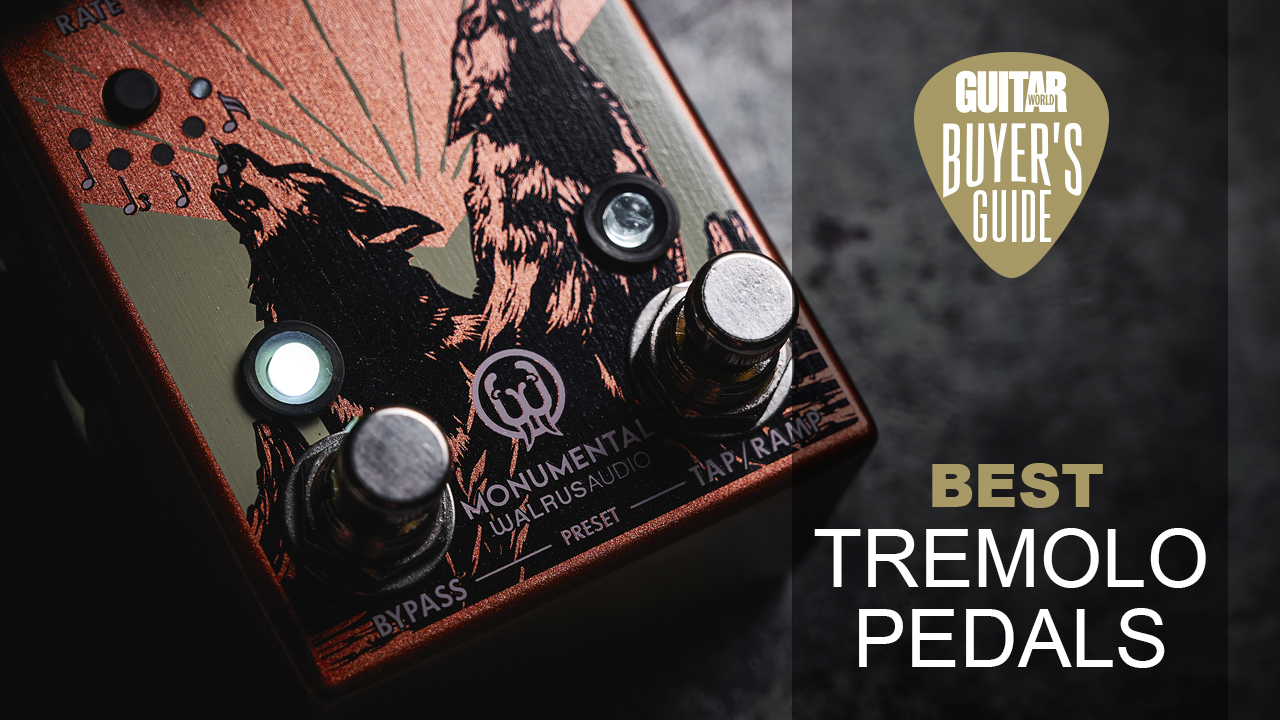
If you've heard My Bloody Valentine's Only Shallow, Link Wray's Rumble, The Smiths' How Soon Is Now? or Green Day's Boulevard Of Broken Dreams, you've heard a song defined by the creative use of tremolo.
Tremolo is a classic effect in a very literal sense, originally built into amps and pre-dating compact effect pedals by decades. For all that heritage, it's still being re-imagined by players to this day.
The best tremolo pedals are deceptively simple. All they do is change the volume of an input signal at a certain rate, with optional additional parameters depending on the unit. As is often the case with effect pedals, the devil is in the detail.
Below, you'll find my top tremolo pedal recommendations, but if you want the top pick straight away, then take a look at the five-star Strymon Flint which offers vast range and it's an ideal purchase if you're a fan of vintage tones.
Got more questions? Head down to our FAQs section where myself and the Guitar World team have practical advice when it comes to buying a new tremolo pedal. Read on for the team's top recommendations.
Our top picks

Yes, it’s the most expensive tremolo pedal on this list, but the Strymon Flint is also the best in my opinion. It’ll cover all your tremolo-related needs from sweet and amp-like to true intensity, all with three different types of reverb too.
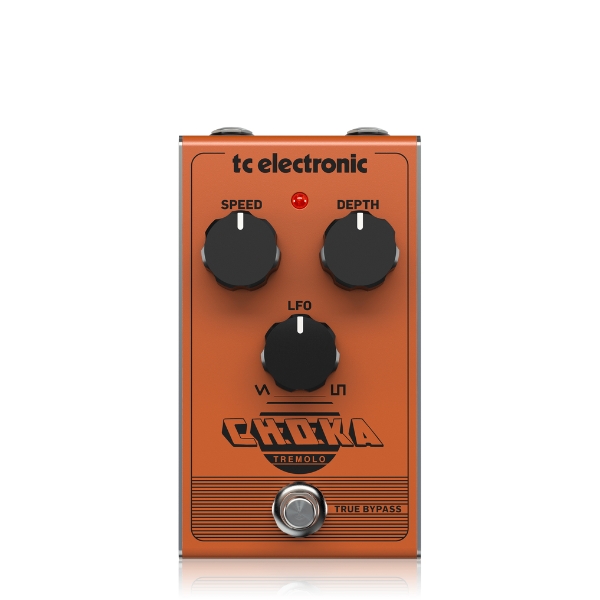
For those on a budget, I’d recommend the TC Electronic Choka. For $45/£35 there’s no better tremolo pedal on the market, and with TC’s signature metal enclosure, smooth footswitch, simple layout and a host of versatile tones onboard, the Choka will do just about anything you can throw its way.
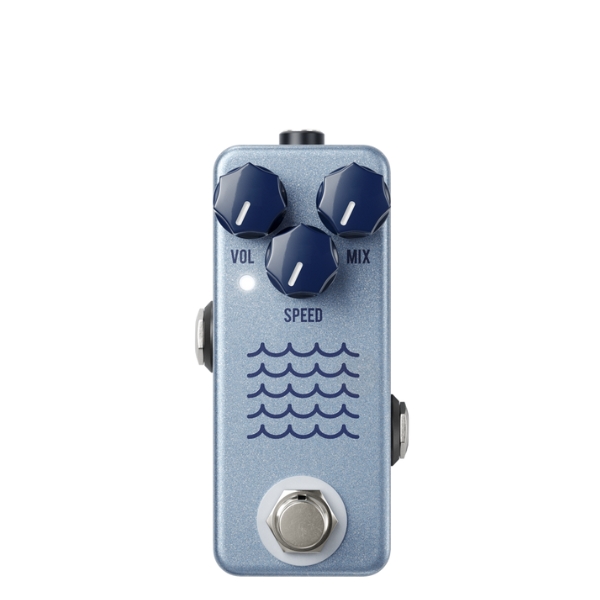
Delivering a wide range of tremolo from subtle and amp-inspired to disruptive square-wave tone-chopping, the JHS Tidewater is my favourite analog tremolo pedal. The compact size makes it perfect for those limited on pedalboard space.
Best overall
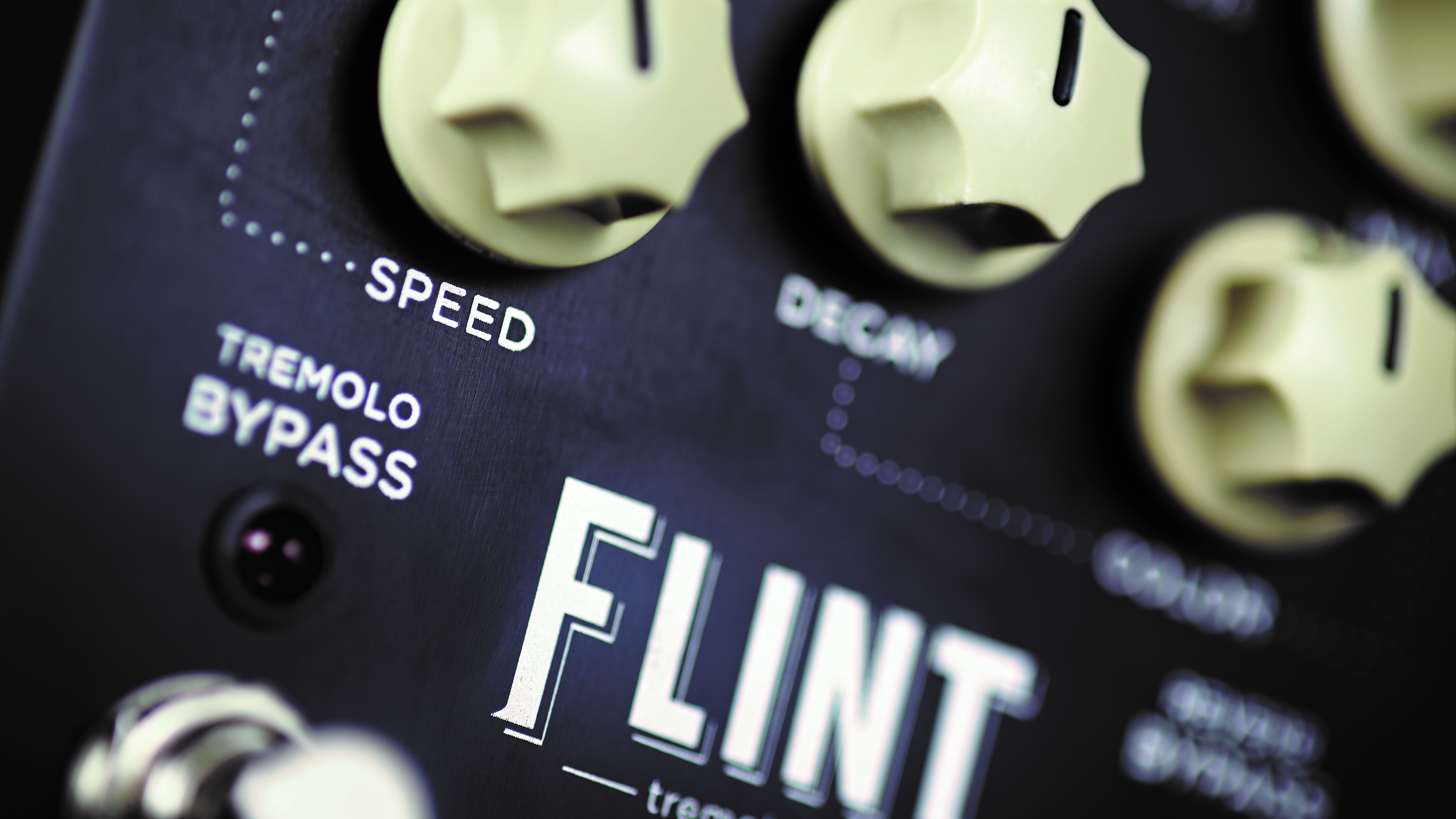
1. Strymon Flint
Our expert review:
Specifications
Reasons to buy
Reasons to avoid
✅ Buy if you enjoy vintage US amp tones: There's plenty to love about the Strymon Flint if classic tones are your thing.
❌ Avoid if you're after more modern tones: There's nothing here for those after modern tremolo tones, so look elsewhere.
Build quality rating: ★★★★★
Usability rating: ★★★★★
Sounds rating: ★★★★★
Overall: ★★★★★
Strymon needs no introduction in any of our pedal guides. If you’ve read any of our other pedal guides, or have had the luxury of being able to try a Strymon pedal, you’ll know just how fantastic these pedals are – and the Flint continues that trend with style. They’re expensive, but they’re so worth it.
Much like the Tre-Verb, the Flint has one side of its enclosure dedicated to tremolo, and as a result the amount of tweakable parameters and controls is limited.
What you do get, however, is intensity and speed controls which have massive ranges. Just from tweaking the intensity control, I found you can go from hardly anything at all to extreme, jarring tremolo – and when you take the speed control into account too, the range of effect you can coax from this pedal is vast.
The tremolo type switch helps to take you through the ages of tremolo in the form of ‘61 harm (a harmonic tremolo), ‘63 tube (a tube bias tremolo) and ‘65 photo (a photocell/optical tremolo) – so if you’re a fan of vintage American amp tones, then this pedal will see you right. You’re really out of luck here if you’re after modern tremolo tones – this pedal is vintage vibe all boxed up.
Best budget

2. TC Electronic Choka
Our expert review:
Specifications
Reasons to buy
Reasons to avoid
✅ Buy if you want a great value for money pedal: This is a versatile tremolo pedal that boasts a nice range.
❌ Avoid if you have a bit more to spend: You'll get more bells and whistles if you have a bit more cash to splash.
Build quality rating: ★★★★½
Usability rating: ★★★★★
Sounds rating: ★★★★½
Overall: ★★★★½
TC Electronic pedals are some of the best around when it comes to buying effects on a budget. Their pedals are all about durability and tonal quality, and the Choka is no exception.
The Choka is a simple pedal, with speed, depth and LFO controls onboard to help craft your perfect tremolo sound. Although there’s not loads that can be tweaked on the Choka, I found each dial has an impressive range of tonal movement – meaning that your tremolo can go from super slow, shallow and vibey to fast, square-wave rhythmic chopping and anything in between.
Like all TC Electronic pedals, the Choka tremolo is true bypass, which delivers a level of tonal purity which far surpasses most pedals of this price bracket.
The pedal itself is enclosed in a metal chassis making it perfect for any type of musical scenario, and the internal circuitry is all-analog. I'm aware that I'm singing TC’s praises an awful lot here, but how can I not when they keep doing great things?
Best analog

3. JHS Pedals Tidewater
Our expert review:
Specifications
Reasons to buy
Reasons to avoid
✅ Buy if you want a compact tremolo pedal that sounds great: The JHS Pedals Tidewater sounds a good as it looks and can double up as a neat boost pedal.
❌ Avoid if you want everything straight out the box: DIP switches are required if you want to access extra features.
Build quality rating: ★★★★½
Usability rating: ★★★★½
Sounds rating: ★★★★★
Overall: ★★★★½
The JHS brand is one of the most highly respected by new artists nowadays. They’re a fairly new company, but the quality of their effects ensures me they’ve been doing their thing for a very long time. ‘Their thing’ just so happens to be making killer effects pedals, and the Tidewater definitely comes under that definition.
If you’ve ever played an old Fender tube amp you’ll understand and appreciate what a slight old-school tremolo effect can do to your tone. The JHS Tidewater wants to recreate that sweet, tasteful amp-style tremolo without taking up too much space – and it does it well.
This pedal looks the same as all of the others in terms of dial layout, but the volume and mix controls have an ace up their sleeve. With the volume up and the mix down, your Tidewater tremolo doubles up as a killer boost pedal – but when you start to bring in the mix level, the volume control offers a great-sounding platform to boost your effected tone for solos or chunky rhythm work.
Best harmonic
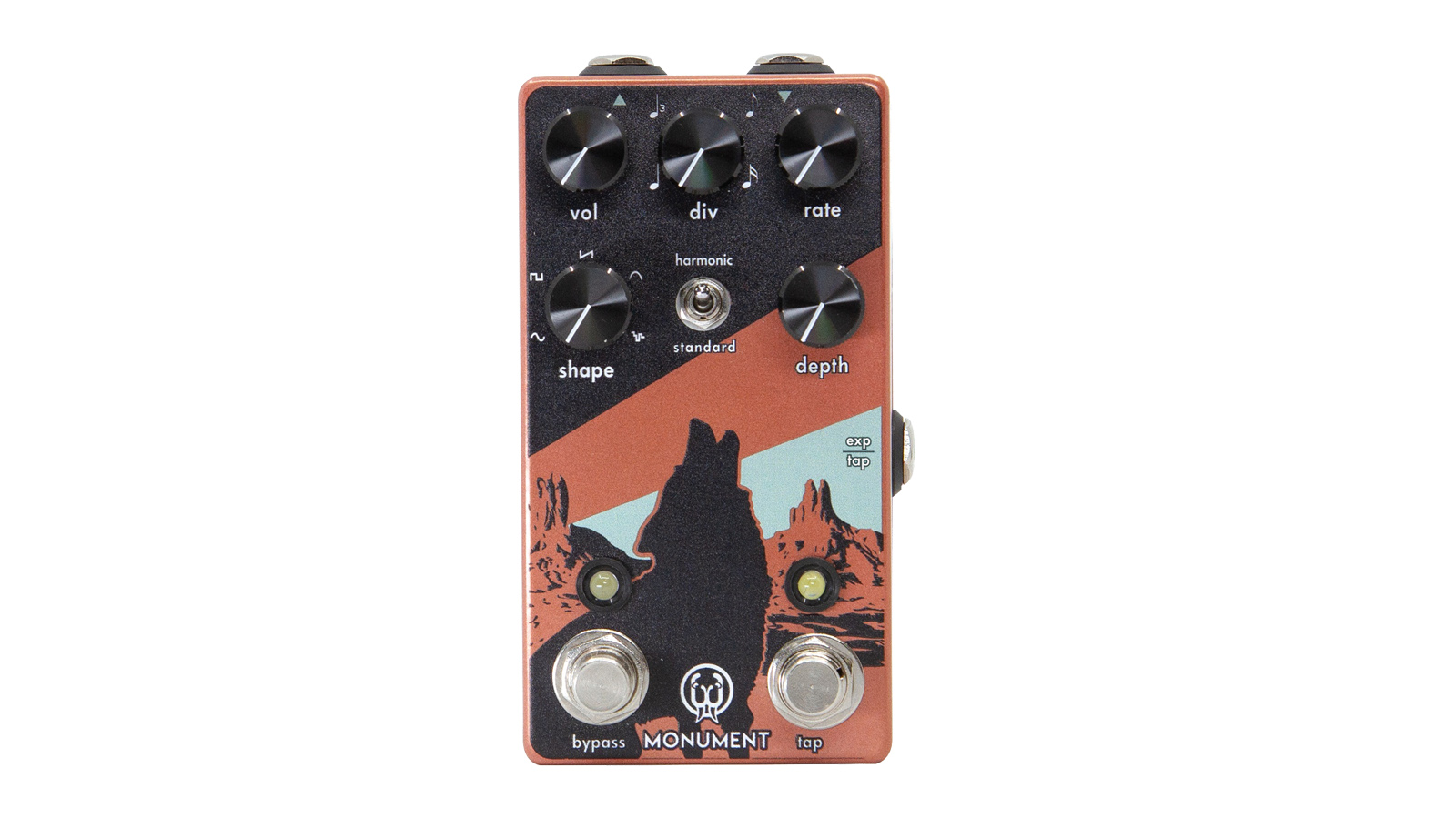
4. Walrus Audio Monument V2
Our expert review:
Specifications
Reasons to buy
Reasons to avoid
✅ Buy if you want an extremely versatile tremolo pedal: There's not much the Monument V2 can't do, making it a top option for your playing.
❌ Avoid if you're new to the world of pedals: With so much going on, newcomers could find the experience a little confusing.
Build quality rating: ★★★★½
Usability rating: ★★★★
Sounds rating: ★★★★
Overall: ★★★★
Walrus Audio is, in the grand scheme of things, fairly new to the party of pedal brands. Having quickly gained a cult following for making some of the very best modulation pedals around in the Julia and the Slö, there’s no surprise at how highly people rate the Monument V2.
The Monument V2 has an exceptional amount of tweakable parameters, and it’s these parameters which help to make the Monument V2 such a versatile pedal.
You’ve got the fairly standard Shape, Rate and Depth controls on board to get you in the tremolo ballpark, and then with the addition of a volume control (to help you cut through a mix) and a ‘division’ control to edit the rhythm of your tremolo, there’s not much this pedal can’t do. The division control can be set to quarter, triplet, eighth or sixteenth notes.
On the Monument V2, you can swap between standard tremolo and harmonic tremolo with the flick of a switch. This takes you from a more modern style to something significantly more vibey and reminiscent of Fender Brownface amps.
The sheer amount of controls on the Monument V2 can prove a little challenging at first, but this pedal is worth putting in some time on – trust me.
Best compact
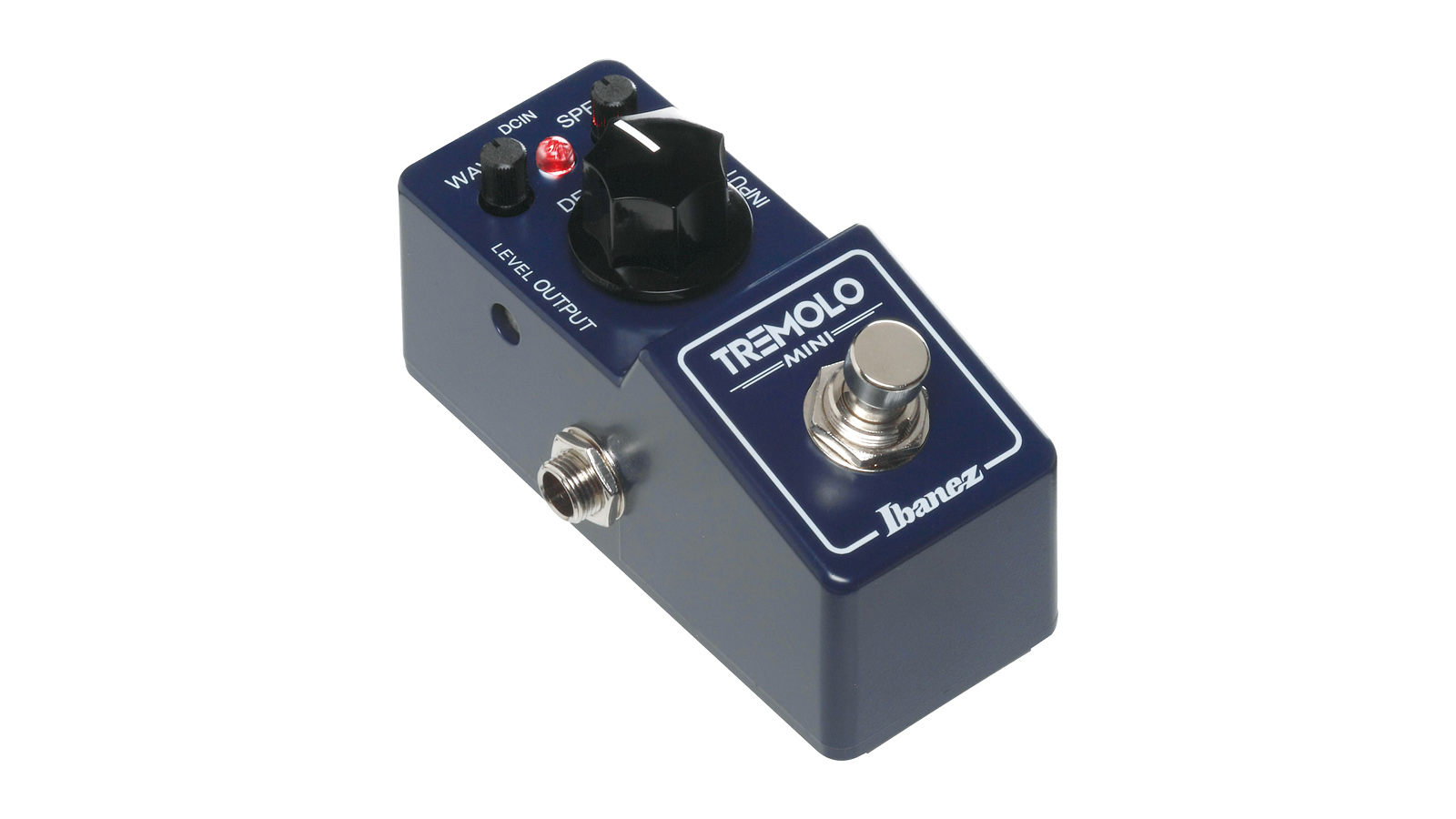
5. Ibanez TRMINI
Our expert review:
Specifications
Reasons to buy
Reasons to avoid
✅ Buy if you're after a small, no-frills tremolo pedal: Easy to use and extremely compact with great sounds, the Ibanez TRMINI is highly recommended.
❌ Avoid if you want a large variation range: Other pedals will be better suited when it comes to depth control.
Build quality rating: ★★★★½
Usability rating: ★★★★½
Sounds rating: ★★★★
Overall: ★★★★½
Ibanez is popular for one range of pedals in particular – the Tube Screamer – but with pedal form that good, I’d be doing them (as well as you) an injustice if I didn’t include the ultra-compact TRMINI in this guide.
The Ibanez TRMINI is one of two mini pedals on this list, and with Ibanez making a huge success of the Tube Screamer mini, I’ve seen this pedal take the exact same format. The footswitch – which has a reassuring clunk to it when pressed – is placed on a raised platform in order to help you avoid knocking any dials with your foot. While this isn’t always successful, it’s thoughtful touches such as this which makes the TRMINI such a great choice.
The tones this pedal produces are up there with some of the best too. For under $100, I was surprised to discover this pedal covers so much ground with its simple setup of knobs. The wave type, speed and depth are all highly tweakable, and while the depth control perhaps doesn’t have the largest range of variation, it still holds up respectfully against other tremolo pedals in this price range.
The level control is designed to help up the output of the pedal, and comes in the form of a recessed screw – allowing you to set and forget.
Best for simplicity
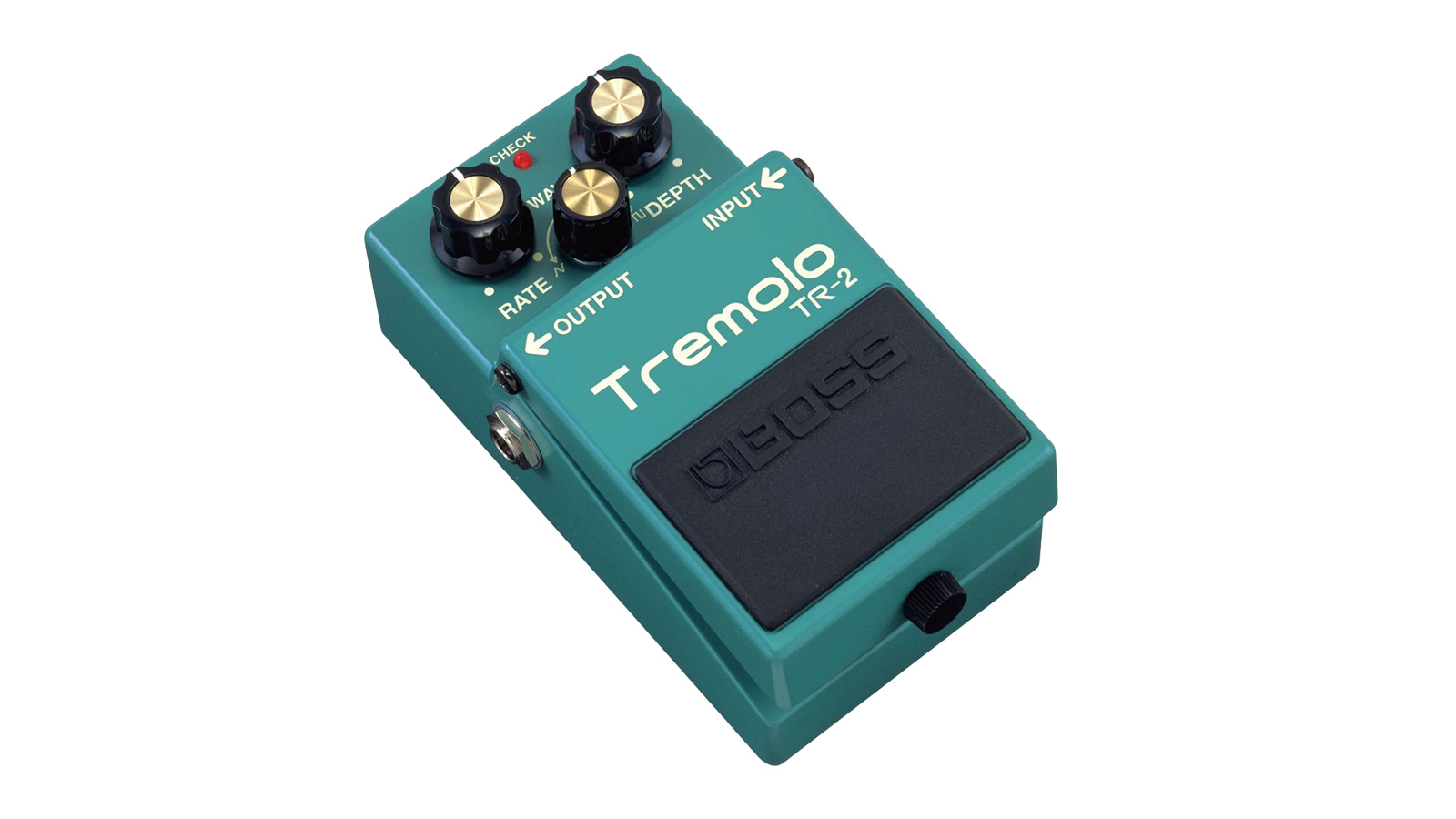
6. Boss TR-2
Our expert review:
Specifications
Reasons to buy
Reasons to avoid
✅ Buy if you want an excellent performer straight out the box: Another easy to use pedal, the Boss TR-2 is a solid performer from the BOSS brand.
❌ Avoid if you want extreme tremolo sounds: This pedal does a lot, but if you want to push the tremolo to the max, there are better options.
Build quality rating: ★★★★★
Usability rating: ★★★★★
Sounds rating: ★★★★½
Overall: ★★★★★
Boss is one of the biggest names ever when it comes to effects pedals, with their products being regarded as some of the greatest to ever have existed. You can expect reliable, usable and high-fidelity tones from all Boss pedals, and the TR-2 is no exception to that rule.
The TR-2 delivers vintage-inspired, warm tremolo tones to suit any player or playing style. Designed to provide some amp-like warble to your tone, the trick to the TR-2’s fame is its simplicity.
Three dials – rate, wave and depth – bring the vintage vibe in spades, where even the most extreme set of parameters still delivers a sensible, musical-sounding effect. As such, it’s not a pedal for those who want extreme tremolo sounds – but it’ll do just about everything else.
The sheer build quality of this pedal is another reason it’s so popular. Like all other Boss pedals, the TR-2 is nigh-on bulletproof, and is ready to be used, loved and gigged hard – hence why we see so many Boss pedals on the ‘boards of the greats. Boss even guarantees the TR-2 with a 5-year warranty.
Best for reverb
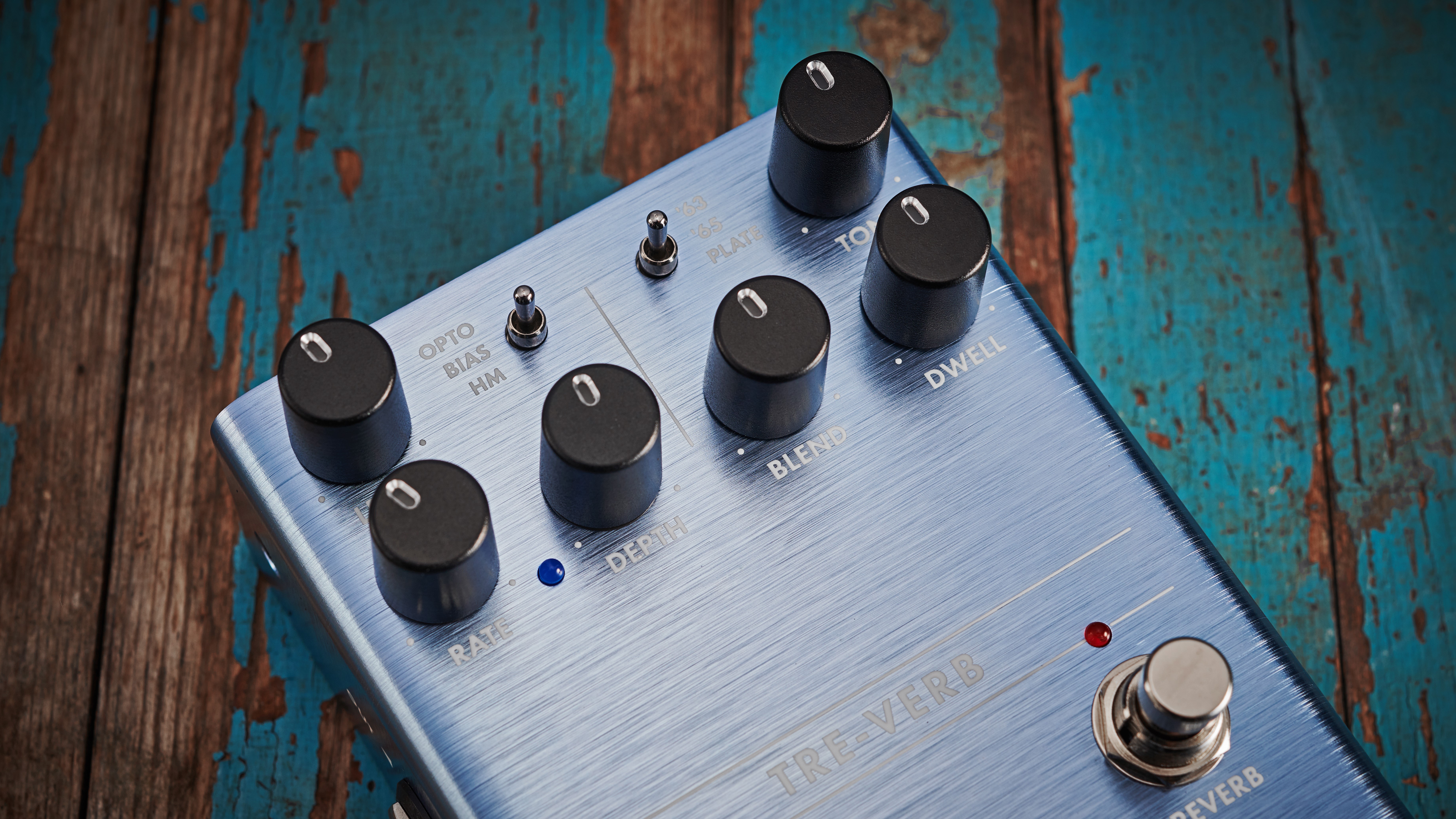
7. Fender Tre-Verb
Our expert review:
Specifications
Reasons to buy
Reasons to avoid
✅ Buy if you want tremolo and reverb: A nice selection of tremolo effects are matched here with reverb, making this a top pedal option.
❌ Avoid if you have no need for reverb: The Fender Tre-Verb offers both tremolo and reverb, so it won't be for everyone.
Build quality rating: ★★★★★
Usability rating: ★★★★½
Sounds rating: ★★★★½
Overall: ★★★★½
When it comes to effects pedals, Fender isn’t a name you’d usually think of. Famous for making some of the world’s best electric guitars and amplifiers (as well as misusing the words ‘tremolo’ and ‘vibrato’), it’s no surprise to us that they’ve turned some of their attention to effects pedals. They’ve done a stunning job.
The Fender Tre-Verb is enclosed fully in lightweight, anodized aluminum to ensure that it can withstand the rigors of touring, live performances and most importantly, getting repeatedly stamped on. As you’ve likely guessed from the name, the Tre-Verb is half tremolo, half reverb – but these effects are independent of one another, as to get the best from each.
The Tre-Verb delivers a super tasteful range of tremolo effects, including Optical, Bias and Harmonic. All of these tremolo types err on the side of classic, but there’s still a wide range of effect to be appreciated here.
The Tre-Verb is, in all honesty, an exceptional pedal. If you don’t need any reverb in your tone, then half of this pedal may be lost on you – but if you’re in the mood for some luscious Fender-amp inspired tones, then this pedal is worth a look.
The layout is simple and straightforward, each parameter has a great range of tonal variation, it’s built like a tank and it looks like something straight from the Apple design playbook. Well done Fender, well done.
Best vintage
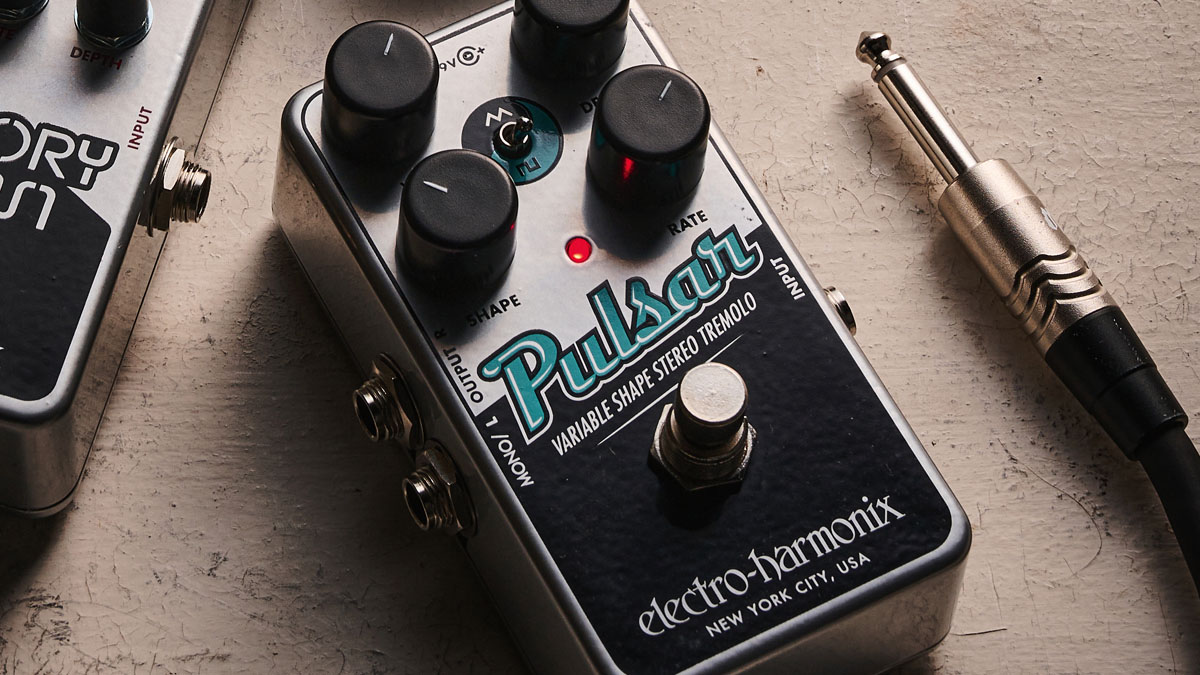
8. Electro-Harmonix Nano Pulsar
Our expert review:
Specifications
Reasons to buy
Reasons to avoid
✅ Buy if you want total control over the tremolo sound: The wave type switch lets you tweak your tremolo to suit a wide variety of play styles.
❌ Avoid if you like a nice clean layout: With so much going on, the pedal is a bit on the overcrowded side.
Build quality rating: ★★★★
Usability rating: ★★★★½
Sounds rating: ★★★★
Overall: ★★★★
Electro-Harmonix is one of the guitar world’s most iconic pedal brands. Well known for creating some frankly incredible effects with a zany twist, EHX hasn’t let me down on this occasion. I often say that EHX pedals are 80% usable, and 20% mental – and I wouldn’t have it any other way.
The Nano Pulsar has a broad feature-set which helps set it aside from other tremolo pedals in this price bracket. It has the seemingly standard depth, rate and shape dials, but the addition of a volume control and a wave type switch enables players to really sculpt and tweak the sound of their tremolo to fit nearly any playing style.
While these extra features make the control panel kind of crowded and prone to being nudged with a foot, the extra parameters make the Nano Pulsar an exceptionally versatile unit.
The Nano Pulsar also features a stereo output, making it easy to pan your tremolo effect between amps to create luscious and wide-sounding stereo effects. This pedal will take you anywhere from smooth to sharp, with some ring modulation-esque tones creeping in as you up the rate and depth controls. I did say it can do some crazy stuff.

"The EHX Nano series is a great space saver, and as this Pulsar tremolo pedal shows it also offers viable substitutes for the larger pedals that inspired them."
Read more: Electro-Harmonix Nano Pulsar review
Best premium
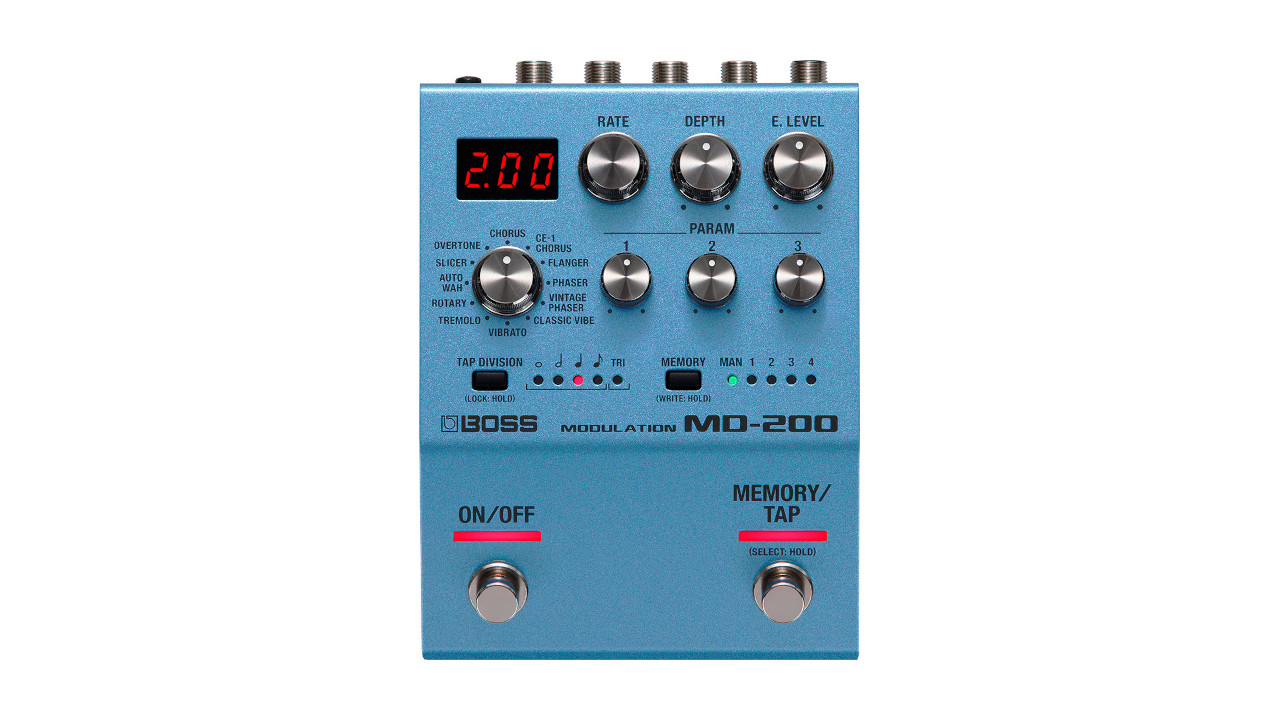
9. Boss MD-200
Our expert review:
Specifications
Reasons to buy
Reasons to avoid
✅ Buy if you a range of modulation options in an all-in-one pedal: Wah, Uni-vibe, flanger, chorus and tremolo are all here.
❌ Avoid if you just want a straightforward tremolo pedal: If it's just tremolo you need, some options here will be redundant.
Build quality rating: ★★★★½
Usability rating: ★★★★½
Sounds rating: ★★★★★
Overall: ★★★★½
The BOSS MD-200 is the smaller sibling of the BOSS MD-500. It's a good choice for the player looking to cover off all modulation options without taking up too much space on their pedal board.
There's modes for wah, Uni-vibe, flanger and chorus but, of most interest here, there's also a tremolo mode. The MD-200 is full stereo, so can emulate the BOSS PN-2 Tremolo Pan as well as standard tremolo.
Like most stereo effects, if you have the set-up for it, stereo operation sounds better than mono.
On each patch there's three parameters. For tremolo they are to select tremolo or pan mode, adjust the waveform, and adjust the tone. There's no esoteric waveforms. The waveform parameter goes from pure sine, through triangle, to square wave. However, for most players, that's enough flexibility.
FAQs
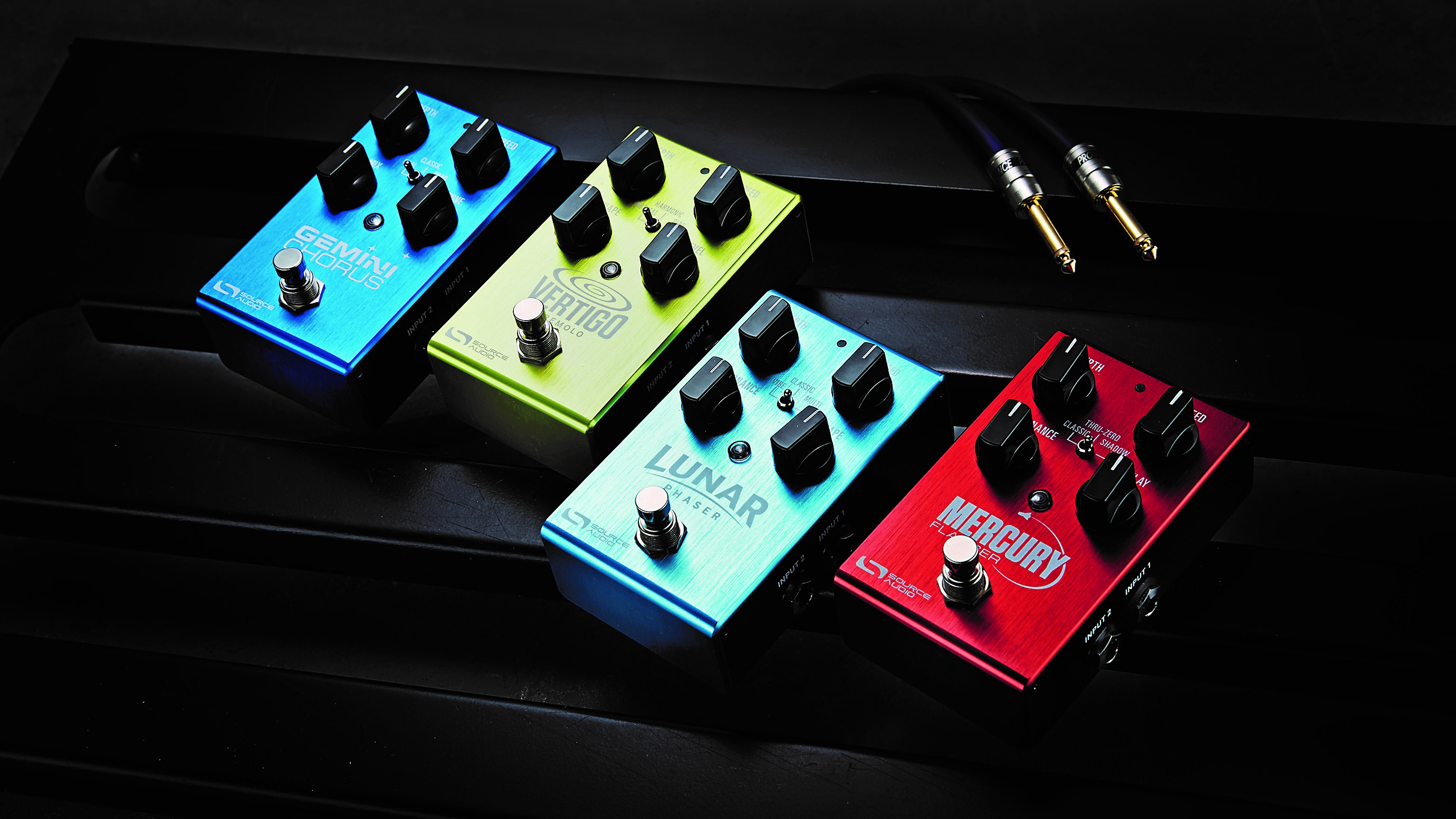
What is a tremolo pedal and how does it work?
Like Chorus, Phaser, Vibrato, and Flange, Tremolo pedals rely on the use of an LFO, or low-frequency oscillator. Simply put, an LFO is a slowly cycling wave that can be used to change some other aspect of your guitar sound. In this case, it changes the volume of the guitar signal, usually in combination with an amplifier circuit in either a tremolo pedal or guitar amp.
Typical tremolo effects use an LFO with a sine-wave shape, resulting in a smooth-sounding ramp up and down of the signal's volume. The other common wave shapes are triangle, for a sharper, less smooth attack and decay, or square-wave, for a choppy, electronic sound.
Almost all tremolo pedals will have two controls that relate to this LFO and its waveform. The first is a 'Rate' control, which controls the speed of the oscillator, and thus the rate at which the signal rises and falls.
The second, the 'Depth' control, can be thought of as the height of the wave. A low depth setting will result in a shallow, subtle tremolo effect. Maxed-out, the difference between loud and quiet is dramatic, with the guitar signal probably being silent in the wave troughs.
What different types of tremolo are there?
There are three main types of analog tremolo: bias, optical and harmonic.
Bias, or 'Tube Bias', was originally found on amplifiers, though there are pedals that recreate it by mimicking the topology of an amp in pedal form. It works by using the LFO to change the bias of the power tubes of an amp, which changes the amplitude of the signal. This effect was a staple of some early Fender amps, and is a distinctive, smooth tremolo effect.
Optical tremolo is an interesting circuit, using a light at its core. The LFO turns the light on and off, changing the resistance in a light-dependent resistor. This is then used to effect the guitar signal, resulting in a smooth, but lopsided tremolo sound. It's sometimes also called an 'optocoupler', or 'photo cell tremolo' due to this interaction between light source and LDR.
The final, and most complicated form of analog tremolo is harmonic tremolo. A high and low pass signal are modulated against each other, 180 degrees out of phase. This means as one is falling, the other is rising, resulting in a distinctive, thick tremolo sound. In general, this is likely what most people have in mind when they think of an 'amp-like' tremolo.
The final bonus type of tremolo is digital tremolo, often found on higher-end modulation units. Some of these offer DAW levels of control. Crucially, you can expect fine-grained access to parameters like waveform. If you've not experienced the magic of tempo-sync'd reverse sawtooth tremolo before, then you've not lived.
Many of these esoteric tremolo options can push the guitar towards synthesizer territory, an impressive feat for something as 'simple' as changing the volume of the signal.
Why do I need a tremolo pedal?
Tremolo pedals are criminally underrated pieces of gear. Just like any other type of modulation or time-based effect, tremolo adds a certain amount of personality to your tone that you otherwise wouldn’t get.
As we mentioned, a tremolo effect ducks the volume of your signal in and out, which can create either a smooth, subtle texture that brings your tone to life, or a harsh, choppy, rhythmic pattern which adds a valuable percussive nature to your performance — think the intro of Boulevard of Broken Dreams.
What's the difference between tremolo and vibrato?
Despite some confusion over the terms in different contexts – I'm looking at you, guitar bridges and Fender amps – the difference is straightforward. Tremolo changes the volume of your guitar signal, while vibrato changes the pitch. Easy, right?
Which brands make the best tremolo pedals?
Tremolo pedals are becoming more and more popular as time goes on, and as such, nearly every pedal company is getting in on the action when it comes to making one. For this reason, many of the best pedal brands also make the best tremolo pedals.
For anyone who likes their pedals to be as small as possible, companies such as Ibanez and JHS offer killer tremolo pedal choices in the TRMINI and Tidewater Tremolo. We’ve seen companies such as Donner, NUX and Valeton offer up super-cheap alternatives which are fine if you’re really in a financial pinch, but as is the case with everything, if you spend more, you’ll most likely get a better product.
We can’t forget the big names either. Boss, Electro-Harmonix and Strymon make some of the industry's best pedals, and their tremolo pedals are truly second-to-none. Boss’ TR-2 is simple, easy to use and chucks out some great tremolo tones, much like the Strymon Flint – which also has a reverb effect built in. These pedals both produce smooth amp-esque tremolo – with the TR-2 also pushing on into slightly more crazy territory.
Fender and TC Electronic sit at either end of this price-ordered guide, but their pedals are equally as impressive for the money. The Fender Tre-Verb is highly sophisticated to the ears, and using it as part of your signal chain is bound to be a highly enjoyable experience.
For a company who, up until fairly recently, hadn’t quite hit the mark with its pedal ventures, the Tre-Verb is emphatic proof that Fender is up near the top, where it belongs. On the contrary, we think that nobody makes budget-friendly pedals like TC Electronic does. The Choka is so cheap, and for the money, there is no better tremolo pedal on the market. Expect to pay roughly double the price of the Choka to get anywhere near that level of quality.
How we choose
At Guitar World, our team of experts has extensive experience playing and testing various guitar products, including bags of tremolo pedals. As dedicated guitar enthusiasts, we understand the importance of achieving the right sound and tone, and we leverage our expertise gained from using these products in live performances, recording sessions, and rehearsals to identify the best tremolo pedals for our guides.
To curate our list of top tremolo pedals, we combine practical experience, user feedback, and in-depth discussions with our editorial team to reach a consensus. We take into account factors such as pricing, features, ease of use, and durability to ensure that we showcase the very best products available on the market.
As guitar players ourselves, we appreciate the value of having the right equipment to create the perfect sound. Therefore, we are committed to providing reliable and knowledgeable recommendations to help guitar players find the ideal tremolo pedal to suit their specific needs and preferences. Our ultimate aim is to assist guitar players in unlocking their full potential by elevating their sound with the best guitar gear out there.
Find out more about how we make our recommendations and how we test each of the products in our buyer's guides.
Why you can trust us
☑️ A global audience of 3.8 million guitarists monthly
☑️ 1,200+ reviews on GuitarWorld.com
☑️ 30+ years of product testing at Guitar World
Guitar World boasts over 44 years of expertise and stands as the ultimate authority on all things related to guitars. The magazine and website feature expertly written gear round-ups and top-quality, authoritative reviews penned by a team of highly experienced industry professionals.
Guitar World's inaugural print issue hit the shelves in July 1980, and ever since, it has been captivating players and enthusiasts with engaging lessons, insightful interviews with the biggest guitar heroes, and priceless buying advice for newbie players.
Furthermore, GuitarWorld.com continues this legacy online and serves as the hub of the world's foremost authorities on guitar playing. The site not only hosts content from Guitar World but also showcases articles from respected publications such as Guitarist, Total Guitar, Guitar Techniques, and Bass Player. With a reach extending to 3.8 million players each month, GuitarWorld.com is a go-to destination for guitar fanatics globally.
Meet the experts

James is a freelance writer and former Junior Deals Writer at Guitar World. Before writing, James worked as a guitar salesman at a local music store, so he knows a thing or two about matching people with their perfect instruments. James also has experience working in other areas of the music trade, having worked for the online music distributor, RouteNote. James is a guitarist, bassist and drummer and has also toured the UK and Europe with his old band Hypophora.

Matt has been recording bands since the mid-noughties, cutting his teeth with an M-Audio M-Track 2 and a copy of Cubase on Windows XP. Since then he's used countless audio interfaces to record music for bands across the UK, covering everything from djent to jazz. As a MusicRadar writer, Matt has reviewed 15 audio interfaces in the past year alone, and over 50 different products including guitars, amps, and pedals. Before becoming a writer, he spent five years in the music retail industry working for Dawsons Music and Northwest Guitars, providing expert advice to musicians. He’s currently studying Music Production at Spirit Studios in Manchester, UK.

Alex Lynham is a gear obsessive who's been collecting and building modern and vintage equipment since he got his first Saturday job. Besides reviewing countless pedals for Total Guitar, he's written guides on how to build your first pedal, how to build a tube amp from a kit, and briefly went viral when he released a glitch delay pedal, the Atom Smasher.
Latest updates
Recent updates
02/04/25: The guide has been updated to include the Boss MD-200 pedal. Reviews have also been highlighted where applicable. The FAQ section has been expanded while all 9 products now feature "at a glance" boxes and star ratings. A section detailing why you can trust the Guitar World team has been added, and there's also now a "meet our experts" section.
Read more
You can trust Guitar World
- Play with yourself: The best looper pedals
- Get all wiggly with the best chorus pedals
- And bring the filth with the best fuzz pedals
- Leave an impression with the best delay pedals
- Or cover up all your mistakes with the best reverb pedals
Get The Pick Newsletter
All the latest guitar news, interviews, lessons, reviews, deals and more, direct to your inbox!
James is a freelance writer and former Junior Deals Writer at Guitar World. Before writing, James worked as a guitar salesman at a local music store, so he knows a thing or two about matching people with their perfect instruments. James also has experience working in other areas of the music trade, having briefly worked for online music distributor, RouteNote. James is a guitarist, bassist and drummer and has also toured the UK and Europe with his old band Hypophora.
- Alex Lynham
- Matt McCrackenJunior Deals Writer
“The original Jordan Boss Tone was probably used by four out of five garage bands in the late ’60s”: Unpacking the gnarly magic of the Jordan Boss Tone – an actual guitar plug-in that delivers Dan Auerbach-approved fuzz
“This is a powerhouse of a stompbox that manages to keep things simple while offering endless inspiration”: Strymon EC-1 Single Head dTape Echo pedal review











